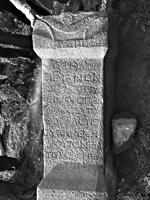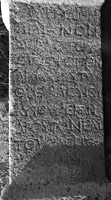 MAMA XI 222 (Kinna)
MAMA XI 222 (Kinna) 
Honorific bomos for Aurelius Aelianus, procurator Augusti
- Type of monument:
- Honorific bomos.
- Location:
- Kulu (Kinna): in a cemetery north-west of the village, south-west of the point where the Ankara road crosses the Değirmen Özü.
- Description:
- Blackish trachyte bomos, complete, with dowel hole on upper surface. Round boss and plain garland (?) on upper moulding.
- Dimensions:
- Ht. 1.57; W. 0.58 (upper moulding), 0.46 (shaft), 0.56 (base); Th. 0.52 (upper moulding), 0.44 (shaft), 0.51 (base); letters 0.040-0.050.
- Record:
- Squeeze; AH notebook copy; photograph (1957/11=5702).
- Publication:
- None.
- Date:
- Second or third century AD.
ἀγαθῇ τύχῃ·
Αὐρήλιον
Αἰλιανὸν
Σεβαστοῦ
5ἐπίτροπον
Αἴλ̣ι̣ο̣ς̣ Εὐτύχιος
θρέψας υἱοῦ
αὐτοῦ Μενάν-
δρου τὸν ἑαυ-
10τοῦ εὐεργέ-
v. την. v.
With good fortune. Aurelius Aelianus, procurator Augusti – Aelius Eutychios, who reared his son Menandros, (honoured him), his personal benefactor.






A close parallel for this text is provided by an inscription from Adada in Pisidia: Ἀντίοχον Τλαμόου φιλόπατριν, ἀρχιερέα τῶν Σεβαστῶν τὸ β΄, πρόβουλον τὸ δ΄, κτίστην, υ[ἱ]ὸν πόλεως, Καλλικλῆς Ἀ[ν]τίοχου ὁ καὶ Δαρεῖος, ὁ θρέ[ψ]ας τὸν νεώτερον τοῦ πάτρωνος υἱὸν Ἀντίο[χ]ον, τὸν ἑαυτοῦ [π]άτρωνα καὶ εὐεργέτην (IGR III 369). In both cases we are dealing with a man of relatively high status (Aurelius Aelianus, procurator Augusti; Antiochos, high-priest of the imperial cult at Adada) being honoured as ‘benefactor’ by the man who had acted as nurse (θρέψας) to his son. For male nurses (nutritores, nutricii) in the Roman world, see Bradley 1991: 37-75. The male nurse, who looked after children too young to be supervised by a paidagogos, seems to have been a quite standard figure in both upper-class and lower-class households, sometimes alongside a female nutrix. In most cases, nutritores would have been slaves or freedmen. See e.g. TAM IV 1, 134 (Nikomedeia), with Robert 1987: 91-4: Θράσων Διογένους τήνδε ἀνέστησεν στυλλεῖδαν υἱῶν β΄, Δεξιφάνους ἐτῶν ε΄, Θράσωνος ἐτῶν δ΄, Ἑρμῆ θρέψαντος αὐτῶν ἐτῶν κε΄· ἐν τῇ συνπτώσει τοῦ σεισμοῦ οὕτως αὐτὰ περιειλήφει, with a relief depicting a bearded slave in a long tunic embracing two togate children.
In the Adada inscription, Kallikles, ‘also known as Dareios’, is all but certain to have been a slave. He is described as ‘son of Antiochos’, and we may suspect that he has been adopted on manumission (Gardner 1989) by his patronus and former owner, the high-priest Antiochos. In our inscription, the status of Aelius Eutychios is unknown; we may suspect that both he and Aurelius Aelianus were imperial freedmen (for freedman procurators in Phrygia and Galatia, see Thonemann 2011a: 113-4), which would place our inscription around the middle of the second century AD.